Si eres nuevo en el bordado, comprender los conceptos básicos del bordado a máquina puede resultar un poco abrumador. Pero no te preocupes: estamos aquí para desglosarlo paso a paso.! En esta guía, Lo guiaremos a través de todo lo que necesita saber para comenzar., desde elegir la máquina y los materiales adecuados hasta aprender puntadas y técnicas básicas.
El bordado a máquina abre infinitas posibilidades creativas, permitiéndote personalizar la ropa, regalos, y decoración del hogar con tus propios diseños. Al aprender estos conceptos básicos, Podrás transformar telas simples en hermosas., piezas personalizadas. Asi que, profundicemos y exploremos lo esencial, ayudándole a desarrollar la confianza y las habilidades que necesita para crear impresionantes proyectos de bordado.
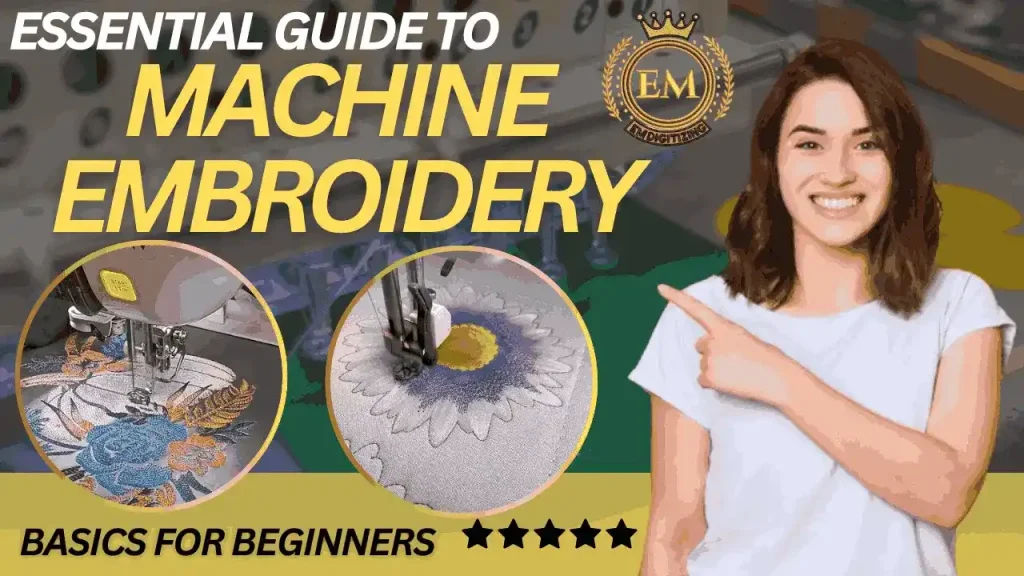
Guía esencial de conceptos básicos del bordado a máquina para principiantes
Materiales básicos necesarios para el bordado a máquina
Comprender los conceptos básicos del bordado a máquina., Es fundamental conocer los materiales y herramientas básicos., incluyendo software, que hacen que el proceso sea fluido y exitoso. Estos son los elementos clave que necesitará:
- Maquina de bordar
- Aros de bordado
- Hilos de bordar
- software de bordado
- Estabilizadores
- Agujas de bordar
- Tela
- Tijeras
Ahora que comprendes los conceptos básicos del bordado., profundicemos en cada componente en detalle.
1. Maquina de bordar
Una máquina de bordar es un dispositivo especializado diseñado para coser patrones y diseños complejos en tela.. A diferencia de las máquinas de coser estándar, Las máquinas de bordar utilizan archivos digitales y costuras automatizadas para producir imágenes precisas., resultados consistentes. Son esenciales tanto para aficionados como para profesionales que buscan aprender los conceptos básicos del bordado a máquina y crear. diseños personalizados o personalizados.
Tipos de máquinas de bordar
Viene en varios tipos, cada uno diseñado para satisfacer diferentes necesidades, desde simples proyectos domésticos hasta uso comercial de gran volumen. Aquí hay un vistazo en profundidad a los principales tipos de máquinas de bordar.:
1. Máquinas de bordar de una sola aguja
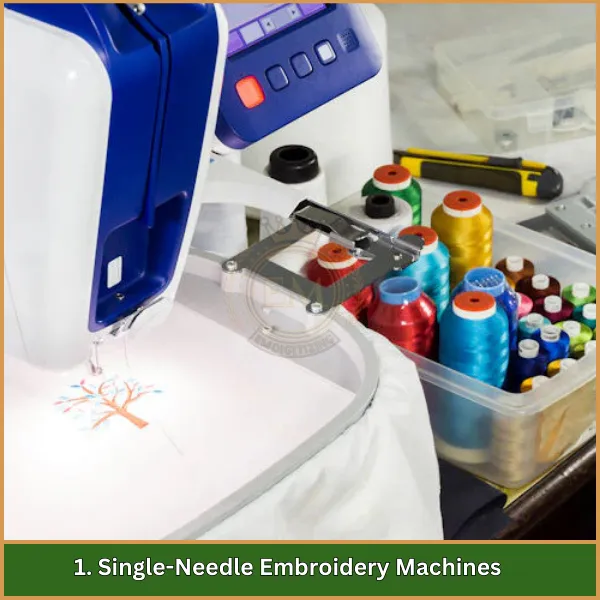
Las máquinas de bordar de una sola aguja son el tipo más común para uso doméstico.. tienen una aguja, lo que significa que la máquina sólo puede manejar un color de hilo a la vez. Para crear diseños multicolores., necesitas cambiar el hilo manualmente para cada color.
Características:
- Facilidad de uso: Las máquinas de una sola aguja son sencillas y fáciles de usar, haciéndolos ideales para principiantes.
- Tamaño compacto: Estas máquinas suelen ser más pequeñas y portátiles., perfecto para configuraciones domésticas.
- Versatilidad: Algunos modelos de una sola aguja también pueden funcionar como máquinas de coser., añadiendo valor para los usuarios interesados tanto en la costura como en el bordado.
Mejor para: Aficionados, principiantes, y los que hacen proyectos de bordado ocasionalmente.
2. Máquinas de bordado de múltiples agujas
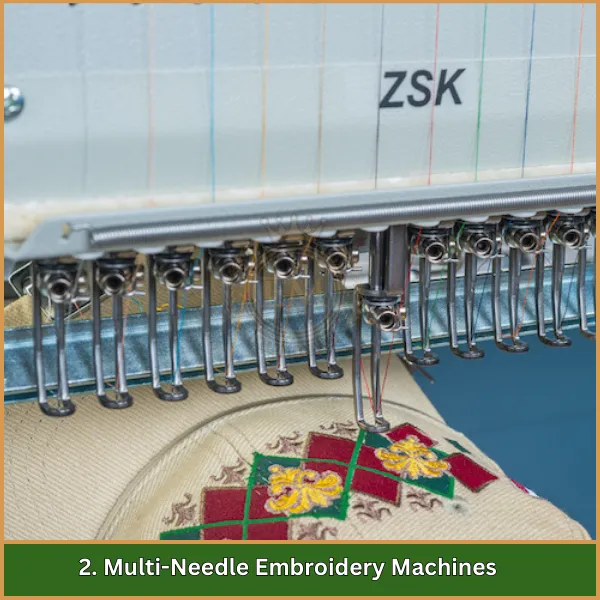
Máquinas de bordar de varias agujas están diseñados para la eficiencia y a menudo son utilizados por profesionales. Estas máquinas tienen múltiples agujas. (típicamente 4 a 10), permitiéndoles sostener múltiples colores de hilo simultáneamente y cambiar automáticamente durante la costura.
Características:
- Velocidad y eficiencia: Las máquinas de agujas múltiples ahorran tiempo al cambiar los colores automáticamente, haciéndolos mucho más rápidos para diseños complejos.
- Tamaño de campo de bordado más alto: Muchas máquinas de agujas múltiples ofrecen campos de bordado más grandes., ideal para diseños más grandes o más detallados.
- Características avanzadas: A menudo vienen con funciones avanzadas como corte automático de hilo., detección de rotura de hilo, y configuraciones de costura personalizables.
Mejor para: Profesionales, propietarios de pequeñas empresas, o cualquier persona que maneje proyectos de bordado complejos o de gran volumen.
Características clave a considerar al elegir una máquina de bordar
Al seleccionar una máquina de bordar básica para principiantes, Algunas características clave pueden marcar una gran diferencia en su experiencia de bordado.. Estas son las principales cosas que debe buscar:
- Diseños y fuentes integrados: Muchas máquinas vienen con diseños y fuentes precargados., facilitando el inicio de proyectos de inmediato.
- Tamaño del campo de bordado: Esta es el área máxima que puedes bordar en un solo bastidor.. Los campos más grandes permiten diseños más grandes.
- Velocidad de costura: Las velocidades de costura más rápidas ahorran tiempo, especialmente para proyectos grandes o diseños detallados.
- Opciones de transferencia de diseño: Compruebe si la máquina admite USB, Wifi, o conexiones directas a la computadora para facilitar la transferencia de diseños.
- Corte automático de hilo: Esta característica corta el hilo entre puntadas., manteniendo su trabajo ordenado y ahorrando tiempo.
- Pantalla táctil a color: Una pantalla táctil a color puede ayudarle a obtener una vista previa y editar diseños con facilidad antes de coserlos..
Cada una de estas características puede mejorar su experiencia de bordado., por lo que resulta útil elegir en función de las necesidades y preferencias de su proyecto.
2. Aros de bordado

Son herramientas imprescindibles en el bordado a máquina., Se utiliza para sujetar la tela firmemente en su lugar mientras la máquina cose diseños.. Garantizan la estabilidad, reducir los cambios, y ayuda a mantener la precisión de cada puntada, Lo cual es crucial para obtener resultados limpios y profesionales.. Aquí hay una mirada en profundidad a los bastidores de bordado y su importancia..
Tipos de aros de bordado
- Aros estándar: Estos son aros básicos que vienen con la mayoría de las máquinas de bordar.. Por lo general, se usan para proyectos más pequeños o diseños simples y son perfectos para principiantes..
- Aros Magnéticos: Los aros magnéticos utilizan imanes para mantener la tela en su lugar.. Son ideales para tejidos delicados que podrían dañarse con los aros de sujeción tradicionales., como seda o algodón fino.
- Aros jumbo o multiposición: Estos aros son más grandes y permiten coser diseños más grandes o de varias partes sin volver a colocar los aros.. Son especialmente útiles para proyectos grandes como mantas., chaquetas, o edredones.
- Aros ajustables: Algunos aros permiten ajustes de tamaño., lo que los hace versátiles para varios proyectos de bordado. Son convenientes al cambiar entre diseños de diferentes tamaños..
3. Hilos de bordar

Son un componente clave en el bordado a máquina., dando vida a los diseños con colores vibrantes, texturas, y acabados. La calidad y el tipo de hilo que elijas pueden afectar en gran medida la apariencia., durabilidad, y el éxito general de su proyecto de bordado. Exploremos los hilos de bordar en detalle para comprender su función., tipos, y consejos para usarlos.
Tipos de hilos de bordar
Comprender los diferentes tipos de hilos de bordar es esencial para dominar los conceptos básicos del bordado a máquina.. Cada tipo ofrece cualidades únicas que pueden impactar el aspecto y la durabilidad de sus diseños..
- Hilo de rayón: Conocido por sus colores vibrantes y brillo., ideal para diseños decorativos con un acabado liso.
- Hilo de poliéster: Durable y resistente a la decoloración, perfecto para prendas que se lavarán con frecuencia, como uniformes y ropa deportiva.
- Hilo de algodón: Tiene un acabado mate, proporcionando un aspecto natural, y es excelente para diseños vintage o más suaves..
- Hilo Metálico: Agrega brillo y textura., ideal para proyectos decorativos, aunque requiere un manejo cuidadoso debido a su naturaleza delicada.
- Hilo de seda: Lujoso y suave, Se utiliza para proyectos de bordado delicados o de alta gama.; se suma una multa, acabado elegante.
- Hilo abigarrado: Cambia de color a lo largo de la hebra., creando un efecto de degradado único que añade interés a diseños simples.
Cada tipo de hilo tiene usos específicos, allowing you to choose based on your project’;s necesidades y efecto deseado.
Pesos y espesores de hilo
Los hilos de bordar vienen en diferentes pesos., generalmente van desde 30 a 60. Los números más bajos indican hilos más gruesos., mientras que los números más altos representan hilos más finos. Elegir el peso correcto es importante:
- 40-hilo de peso Es el más común y funciona bien para bordado general..
- 60-hilo de peso es más fino y adecuado para diseños detallados o letras pequeñas.
- 30-hilo de peso es mas grueso, ideal para diseños atrevidos que deben destacarse.
4. software de bordado
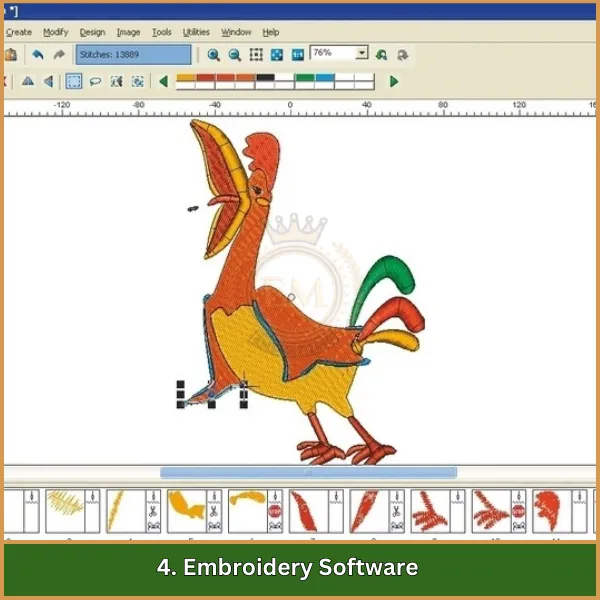
Es una herramienta vital para crear, edición, y convertir diseños en bordado a máquina. Permite a los usuarios personalizar patrones., ajustar tipos de puntadas, e incluso convertir imágenes a formatos compatibles con el bordado. Con el software adecuado, Tanto principiantes como profesionales pueden dar vida fácilmente a sus ideas creativas sobre tela..
Propósito del software de bordado
El software de bordado cumple múltiples funciones, desde la creación de diseños básicos hasta la edición avanzada. Permite a los usuarios:
- Crea diseños originales: Dibuja o importa formas y patrones para crear. diseños de bordado únicos.
- Editar patrones existentes: Modificar diseños existentes cambiando el tamaño, giratorio, o cambiar colores para adaptarse a los requisitos del proyecto.
- Convertir archivos: Transformar archivos de imagen estándar (como JPEG o PNG) en formatos de archivos de bordado (como horario de verano, PSA, o EXP) que las máquinas pueden leer.
- Vista previa de diseños: Vea cómo se verá el diseño cuando lo cosa, permitiendo ajustes antes de comenzar el proceso de bordado.
Funciones clave a buscar en el software de bordado
- Interfaz amigable: Una interfaz sencilla es útil, especialmente para principiantes, ya que hace que aprender el software sea más rápido y más fácil.
- Opciones de personalización del diseño: Busque funciones como agregar texto, cambiar el tamaño, ajustes de color, y capas para personalizar cada diseño.
- Compatibilidad de archivos: Asegúrese de que el software admita los formatos de archivo que lee su máquina de bordar, como horario de verano, PSA, o JEF.
- Vista previa y simulación: Le permite obtener una vista previa de cómo quedará el diseño en la tela., ayudando a identificar cualquier problema potencial antes de coser.
- Edición de puntadas: Algunos programas permiten la edición avanzada de tipos de puntadas., densidad, y direccion, lo cual es beneficioso para diseños más complejos.
5. Estabilizadores
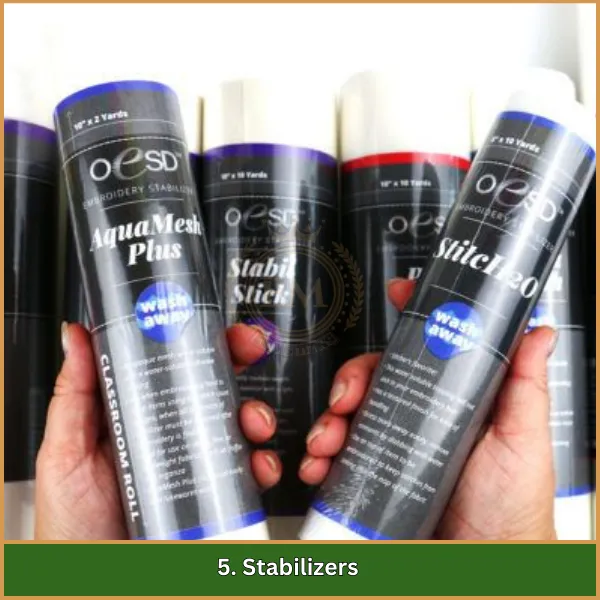
Son materiales esenciales que se utilizan en el bordado a máquina para brindar soporte y evitar que la tela se estire o se deforme durante la costura.. Ayudan a mantener la forma del tejido., prevenir arrugas, y asegúrese de que los puntos permanezcan limpios y bien definidos. Elegir el estabilizador adecuado es crucial para lograr resultados de bordado de alta calidad., especialmente en tejidos difíciles.
Tipos de estabilizadores
- Estabilizadores recortables: Proporcionan soporte permanente y permanecen adheridos a la tela después de coser.. Son mejores para telas elásticas o delicadas que necesitan una estabilidad duradera..
- Estabilizadores desprendibles: Diseñado para soporte temporal, Se arrancan fácilmente después de coser.. Ideal para telas estables como algodón y mezclilla que no requieren respaldo a largo plazo.
- Estabilizadores solubles en agua: Se disuelve completamente en agua., sin dejar rastro atrás. Perfecto para diseños de encaje o telas transparentes donde no quieres ningún estabilizador visible.
Estabilizadores que eliminan el calor: Se elimina aplicando calor., haciéndolos ideales para telas que no se pueden lavar ni rasgar. Estos estabilizadores funcionan bien con materiales delicados o especiales..
6. Agujas de bordar
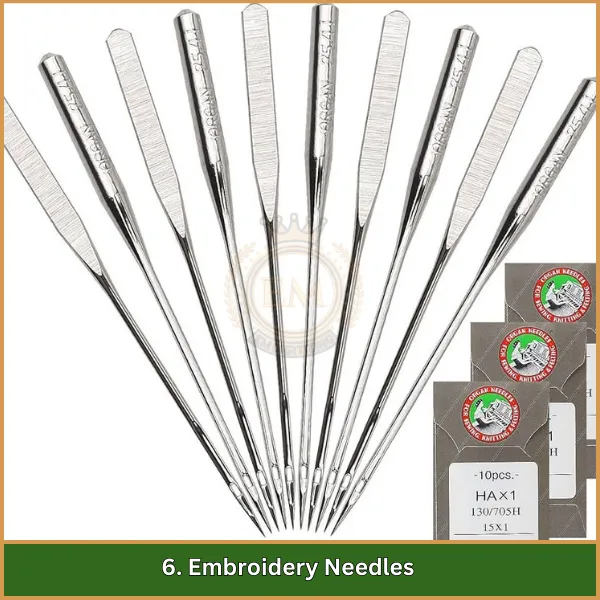
Están especialmente diseñados con ojos más grandes y una suave, punta redondeada para manejar hilos de bordar sin causar deshilaches ni enganches. Elegir el tamaño y tipo de aguja correctos es esencial para lograr una limpieza, puntadas uniformes en varios tipos de telas.
7. Tela
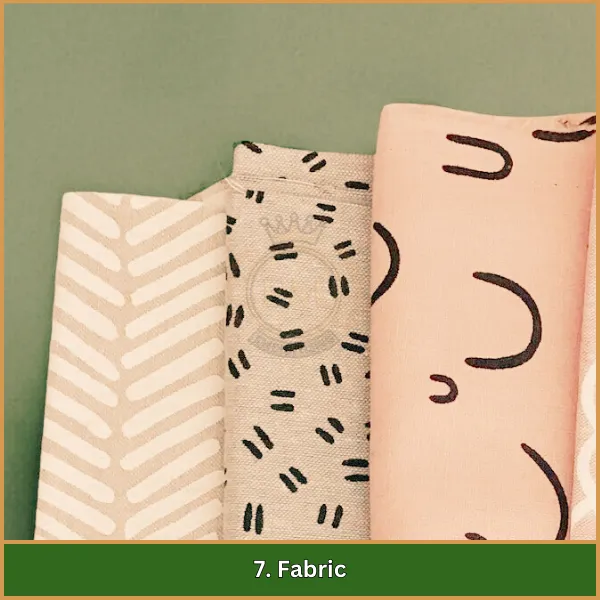
Es la base para cualquier proyecto de bordado., y elegir el adecuado puede afectar mucho al resultado final. Diferentes tejidos interactúan de forma única con hilos y estabilizadores., por lo que seleccionar el tipo de tela adecuado es importante para un acabado suave y profesional..
8. Tijeras
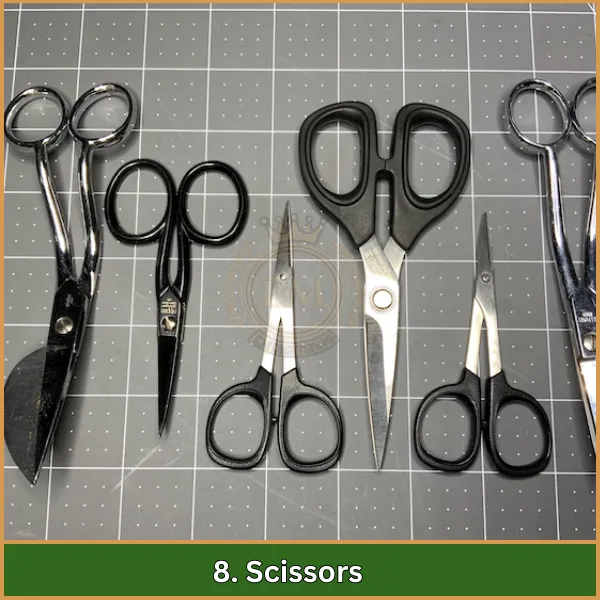
Son herramientas esenciales para recortar hilos., estabilizadores de corte, y terminar con precisión los proyectos de bordado. Tener el par de tijeras adecuado hace que el proceso de bordado sea más fluido y ayuda a lograr un bordado limpio., acabado profesional.
Comprender los diseños de bordado a máquina
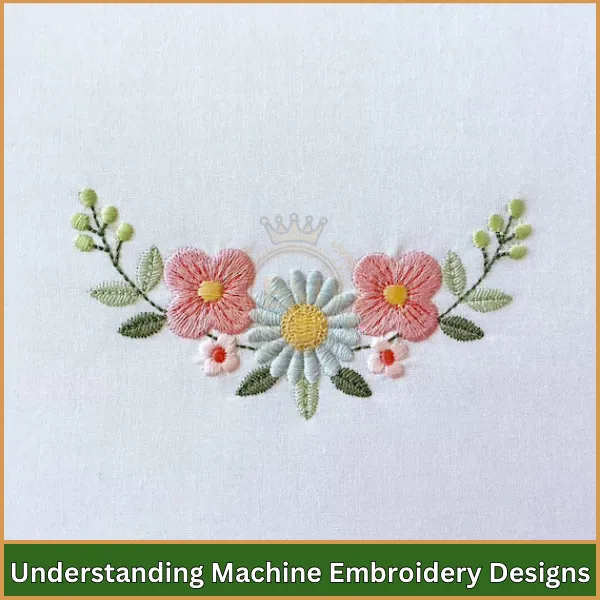
Son patrones digitales que guían a la máquina de bordar en la creación de imágenes detalladas., logotipos, y texto sobre tela. Sin embargo, simplemente tener un diseño no es suficiente; para lograr profesional, resultados pulidos, Los diseños deben pasar por un paso crucial llamado digitalización..
Este proceso convierte el diseño a un formato legible por máquina con instrucciones precisas sobre cómo se debe hacer cada puntada.. If you’;Solo estás aprendiendo los conceptos básicos del bordado a máquina., Recomendamos encarecidamente contratar a un profesional para la digitalización., ya que requiere experiencia para ajustar los tipos de puntadas, densidades, e instrucciones basadas en las complejidades de la tela y el diseño.
Para obtener resultados de bordado impecables, Es muy recomendable contratar un digitalizador profesional.. EMdigitalizing ofrece d excepcionalservicios de ignición para transformar sus diseños en archivos de bordado de alta calidad. Nuestro equipo de expertos en EMdigitizing utiliza las últimas técnicas para garantizar que cada diseño se adapte perfectamente a su tejido y máquina., ofreciendo una experiencia de bordado perfecta.
Al elegir EMdigitalización, está invirtiendo en precisión y calidad que realmente distinguen sus proyectos de bordado. Permítanos manejar las complejidades de la digitalización para que usted pueda concentrarse en crear hermosas, bordado detallado que dura. Haga su pedido ahora para obtener un acabado profesional en el que pueda confiar!
Formatos de archivo para diseños de bordado
Se guardan en formatos de archivo específicos que las máquinas de bordar pueden leer e interpretar.. Cada marca de máquina puede requerir un formato diferente, por eso es importante saber qué tipo de archivo se adapta a su equipo.
- horario de verano: Un formato muy utilizado, especialmente para máquinas de bordar comerciales.
- PSA: Comúnmente utilizado con máquinas de bordar Brother y Baby Lock..
- JEF: Utilizado por máquinas Janome y compatible con varias máquinas de bordar domésticas..
- Exp: Compatible con máquinas Bernina y otras máquinas de nivel profesional..
Elegir el formato de archivo correcto es esencial para lograr los mejores resultados con su máquina. Garantiza que los detalles y especificaciones de las puntadas de su diseño se transfieran con precisión., dando como resultado un producto final pulido.
Comprensión de las puntadas básicas de bordado a máquina
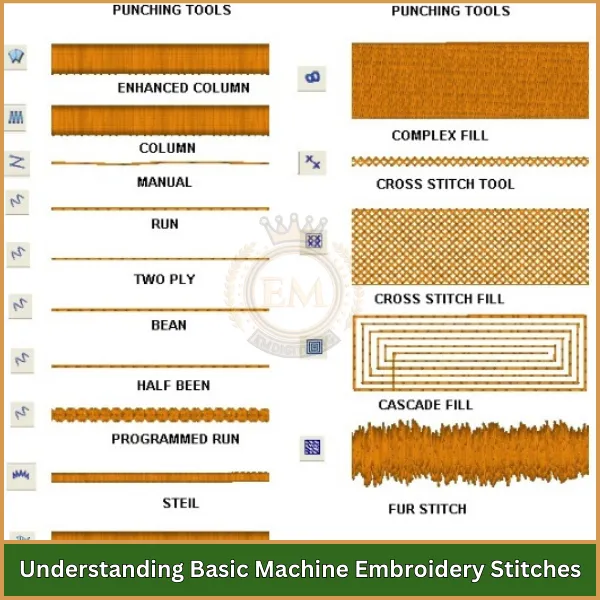
Al aprender los conceptos básicos del bordado a máquina, Comprender los diferentes tipos de puntadas es esencial para crear diseños de alta calidad.. Cada tipo de puntada agrega una textura única, dimensión, y detalle a tus proyectos de bordado. A continuación se muestran los puntos más comunes utilizados en el bordado a máquina.:
- Puntada de satén: Conocido por su suave, acabado brillante, La puntada satinada se usa comúnmente para letras y contornos.. Crea una densa, Línea atrevida y es ideal para agregar énfasis a ciertas áreas de un diseño..
- Puntada de relleno (Puntada de tatami): Esta puntada cubre áreas grandes con un relleno consistente y se usa a menudo para fondos o formas sólidas.. El patrón de puntadas evita las arrugas y proporciona un equilibrio, apariencia texturizada.
- puntada corriente: Un simple, puntada de una sola línea utilizada para delinear, detallando, o crear líneas finas en un diseño. Es rápido y económico, haciéndolo adecuado para detalles ligeros.
- Puntada De Frijol (Puntada triple): Una puntada continua reforzada que pasa por cada línea tres veces., creando un más audaz, línea más duradera. Las puntadas de frijol son excelentes para delinear y agregar definición..
- Puntada en zig-zag: Esta puntada se alterna en forma de zigzag., agregando textura y una calidad ligeramente elástica. Es útil para asegurar bordes o agregar un detalle llamativo..
- Cadeneta: Imitando una apariencia cosida a mano., El punto de cadeneta se utiliza a menudo en bordados decorativos.. Crea una textura, efecto de bucle, añadiendo profundidad y carácter al diseño.
- Punto de cruz: Se utiliza para crear una cuadrícula o un patrón texturizado., El punto de cruz se ve a menudo en diseños más tradicionales y agrega un toque único., encanto pasado de moda.
- Nudo francés: Una puntada especial que crea pequeños, nudos elevados para agregar detalles y textura a partes específicas del diseño, como centros de flores o acentos.
Dominando estos puntos básicos de bordado a máquina, puedes crear hermosas, Diseños versátiles con una variedad de texturas y efectos., dando vida a tus proyectos con estilo y precisión.
Conclusión
En conclusión, Dominar los conceptos básicos del bordado a máquina lo encaminará hacia la creación de hermosos, piezas personalizadas con confianza. Ya sea que estés comenzando o perfeccionando tus habilidades, Tener diseños bien preparados es esencial para lograr resultados impecables..
Para servicios de digitalización de máxima calidad, confíe en EMdigitalización! Ofrecemos las tarifas más asequibles., tiempos de respuesta súper rápidos, y garantía de calidad en cada diseño. Más, con nuestra opción de vista previa, Puedes ver exactamente cómo quedará tu diseño antes de coserlo..
Y si es tu primera vez con nosotros, recibirás una exclusiva 50% apagado. Haga su pedido ahora y deje que EMdigitizing haga realidad sus ideas creativas con precisión y excelencia.!
